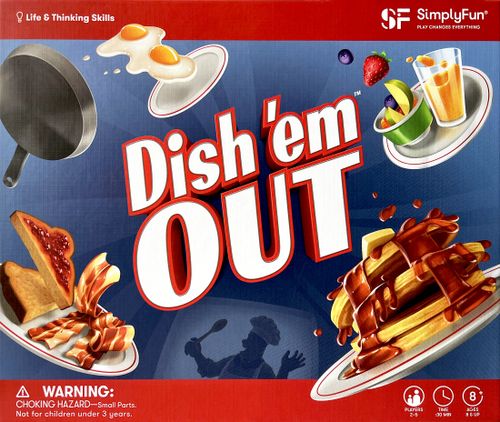Description
Rival diner owners are under pressure to cook breakfast for their customers as quickly as possible. As some foods take longer to cook, you will need to plan ahead so the entire order is ready to serve at the same time. Players receive points for each successfully completed order and lose points for wasted food and incomplete or incorrect orders. The player with the most points when the flow of customers runs out is the winner.
Setup
Each player chooses one diner board and places it in front of them.
Sort and place the food tiles and penalty tokens into each slot of the kitchen caddy.
Shuffle the customer order cards. Based on the amount of players, remove the number of cards needed and place the remaining cards back in the box (see chart at right).
The first person to shout out what they ate for breakfast will deal first. Give them the chef’s spoon and cards.
How to Play
This game is played in rounds. Each round consists of the following actions:
1. Dealer assigns customer order cards.
2. All players select food tiles.
3. All players cook food items.
4. All players serve their customers, if they are able.
After all four actions are completed, the chef’s spoon and the customer order deck are passed clockwise to the next player, and a new round begins.
1. Assigning Customers
The player with the chef’s spoon is the dealer for each round. The dealer draws customer order cards equal to the number of players. The dealer then assigns one customer order to each player, including themselves. You can keep a more difficult card with the higher risk and point value for yourself or assign it to an opponent in hopes of giving them more than they can handle. All players then place their customer order cards on an empty table space within the Orders section of their diner board. In later rounds, if all the table spaces on a player’s diner board are full, they must immediately serve one of their current customers, even if that order will be incomplete, before receiving a new customer order card for that round.
2. Selecting Food Tiles
Starting with the dealer, players take turns in clockwise order selecting food tiles from the kitchen caddy based on their orders and cooking times. Each player may take up to a total of seven food tiles, from up to three different food types. This is the maximum; you are not required to select more food tiles than you want or need. Take your selected food tiles, and place them in a stack on their corresponding spaces in the Prep column of your diner board.
3. Cooking Food
All players cook their food at the same time. When everyone is ready, the dealer for the round announces, “Cook time!” Now, starting with the top row and working your way down, move all food tiles on your diner boards one space to the right. Keep each round’s stack of tiles together as they move across the board. Some food types do not need to stop in each column. When a tile reaches a space with an arrow, slide it across the arrow until it reaches the column indicated. Once food items are in the Ready to Serve spaces, they can be used to serve any combination of orders (see Serving Customers section).Any unserved food in the final column of the Ready to Serve section will be moved into the Trash column during cook time.
4. Serving Customers
Players may serve their customers during actions 1 or 4 using any food tiles that are in the Ready to Serve area. When you are ready to serve a customer’s order, move the food tiles from your Ready to Serve area and place them on the corresponding spaces of the customer order card to check that you have the correct food items.
End of Game
Complete the round in which the last customer order cards have been assigned. Then the game enters the final phase. Still taking turns going clockwise, each player has the chance to select one last set of food tiles to place on their diner board. Cooking then occurs as normal. The final phase then continues with all players cooking their food and serving their remaining customer orders (repeating actions 3 and 4). The game ends once all customer order cards are removed and all food tiles have been served or moved into the Trash column.
Scoring
Players total the scores from their served customer order cards and subtract any penalty tokens received to determine their final scores. The player with the most points wins. In the case of a tie, the player with the fewest penalty tokens wins. If there is still a tie, the player with the five highest-point customer order cards wins.
-description from publisher


Comments (0)